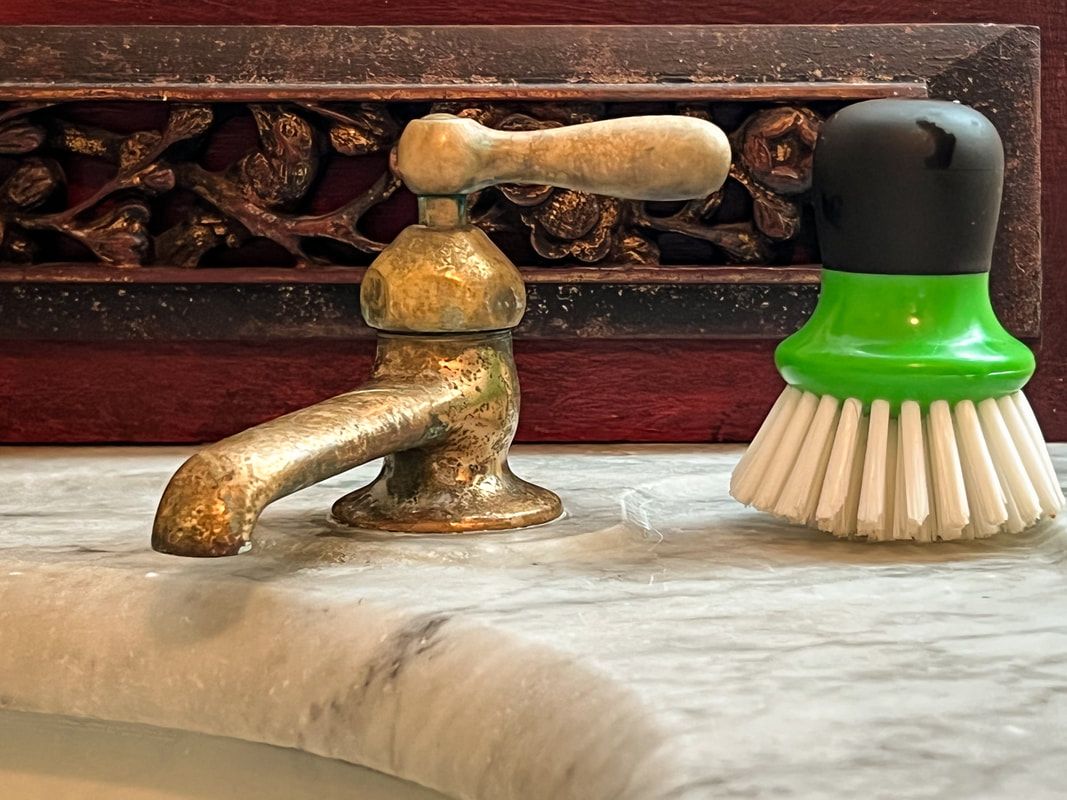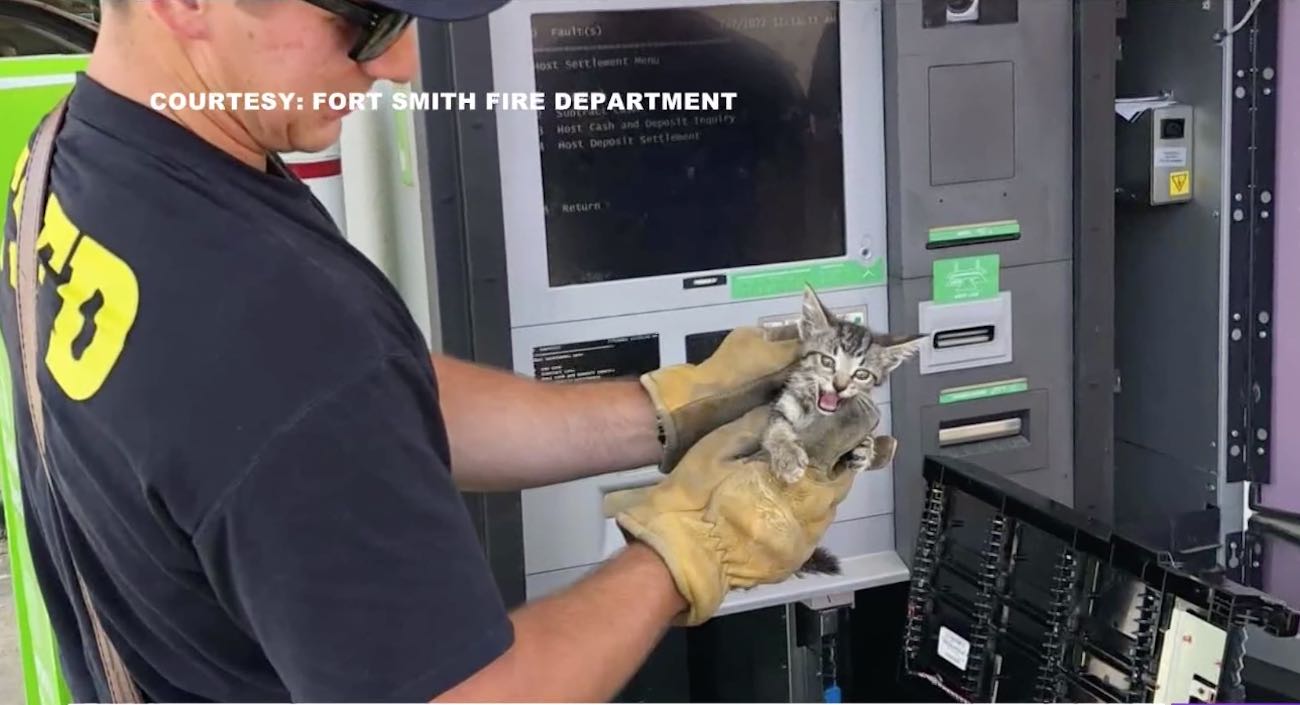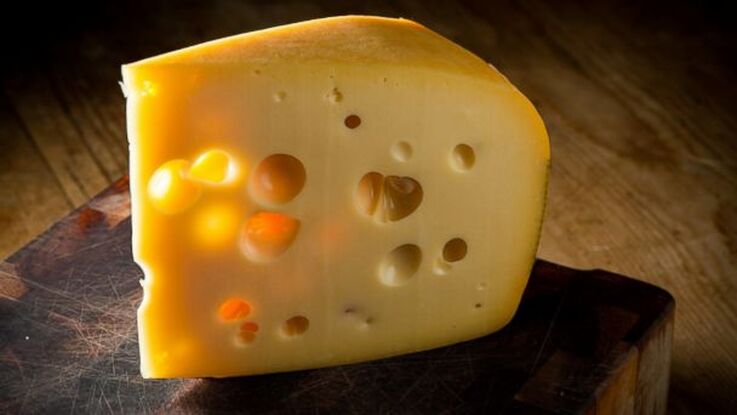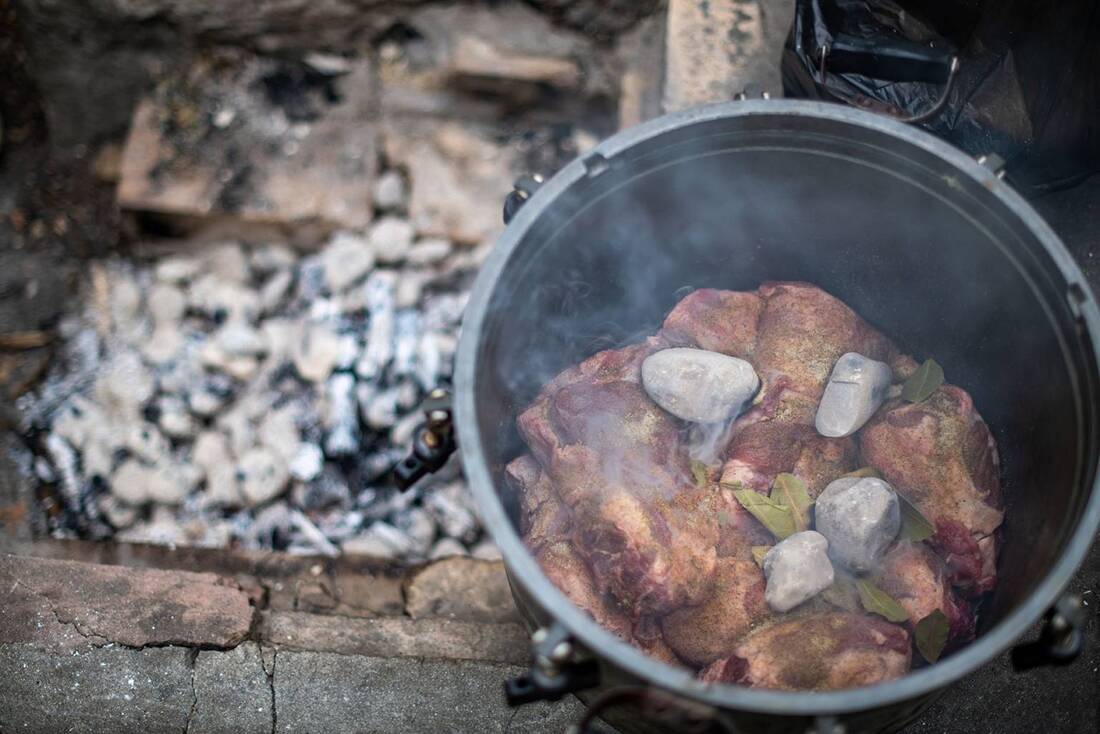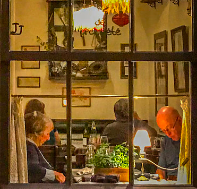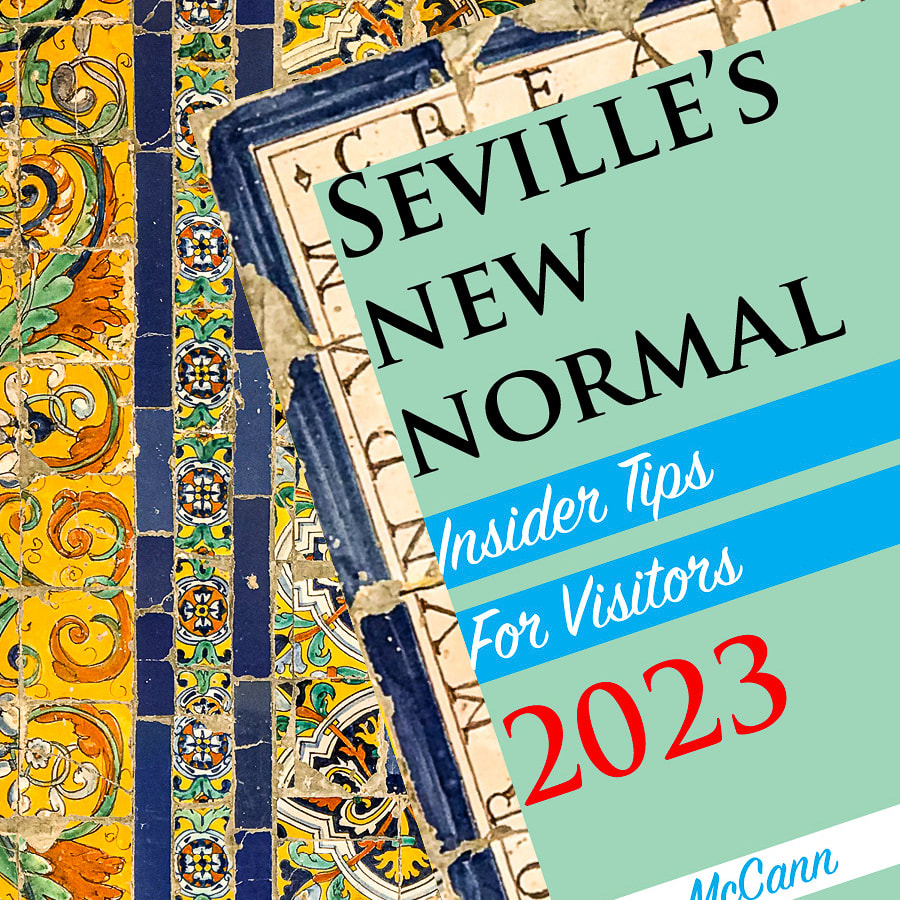|
“How can this even be legal?” I was staring aghast at the squishy tube in my hands. I had searched every meat counter, deli section, and cold case to find what was apparently the only soft chorizo sold in this vast supermarket. My triumph at the discovery soon plummeted into dismay as I began reading the ingredients. “This contains pork salivary glands and lymph nodes.” I turned to Rich. “I can’t serve my guests stuff like that.” “You should stop reading labels,” he said. “But—” “We need chorizo for the paella.” He took the tube out of my hands and tossed it into the cart. “It’ll be fine.” He had a point. Pretty much anyone who’s eaten hot dogs, sausage, or chorizo has consumed various unspeakable parts of the pig, and it was just a quirk of stricter labeling laws that I could no longer maintain my blissful ignorance. I had a brief tussle with my conscience about whether I should reveal the unnerving truth to my guests but was forced to conclude they were better off not knowing. Especially as I was going to have to put them on high alert about the newly discovered health hazards of my drinking water. The night before, I’d discovered that my faucets were leaking a foul black sludge. This being the weekend, professional help was unavailable, so I bought a water testing kit, stocked up on bottled water and hand sanitizer, and consulted Google to find out what I might be up against. I learned that most likely the sludge started with a mineral called manganese, which is not hazardous; in fact, it helps our bodies form connective tissue, bones, and sex hormones. So far so good. However, if this theory proves correct, the thick black sludge isn't the manganese itself, it's the masses of bacteria that gather to feast on manganese. Several articles blithely assured me these bacteria were “harmless.” Then I learned these bacteria were only formally identified in 2020. “The bacteria, tentatively christened Candidatus Manganitrophus nodulliformans and Ramlicbacter lithotrophicus, can borrow electrons from metals like manganese and use them as fuel for growth,” reported Science magazine. I find this less than totally reassuring. These little critters are so new scientists haven’t even settled on names yet, so I’m wondering how they can be so sure they're safe for human consumption. Historically, scientists have praised the beneficial effects of mercury, tobacco, bloodletting, tapeworms, cocaine, electroshock therapy, and lobotomies. Frankly, I’d like a second opinion about my manganese-eating bacteria. Perhaps more worryingly, the test kit revealed the level of manganese in my water is (drum roll, please) absolute zero. Is this because our bacteria have consumed it all? Are they now looking around for something else to devour? Dimly remembered highlights from The Blob and the bathtub scene from Ghostbusters II began oozing through my brain. Ah, the joys of home ownership. I do love my cottage, which was built in 1900 on a small plot of land, providing endless puttering and repair projects, plus just enough gardening to keep Rich’s thumb green. This is where we live during the six months a year we’re in California (the other six we’re in Spain) and every once in a while we sit down and review alternatives. Would life be better, we wonder, in a place that didn’t require quite so much maintenance? Or wake us up at 4:30 in the morning — as happened today — to announce with beeping alarms the carbon monoxide monitor needs new batteries? What about apartment living? With this in mind, we made a spur-of-the-moment visit to look at a big apartment complex in nearby Novato, close to the charming main street and the newly reopened train station. The apartments were big and handsome — as they should be, for five times the rent we pay in Seville — and the common spaces and rooftop gardens were beautifully designed. But they’d skimped on the corridors, making them narrow, gray, and absolutely featureless, like something from a dystopian movie. “The corridors go on for two miles,” said the sales agent brightly. “Good for walking on rainy days.” “With my ability to get lost,” I said, “it would be more like four miles.” I wondered if anyone would mind my leaving a trail of breadcrumbs so I could find my way around. A few discreet enquiries among friends my age revealed many are already selecting a senior living community with a spectrum of care. “If you don’t, all the good ones will be taken,” one friend confided. “You don’t want to have to settle.” Yikes! Maybe I ought to look into this. So I fired up the laptop and dug in. “Why is everything beige in these places?” I muttered to Rich. “It would be like living in a vat of oatmeal.” I learned luxury senior accommodations tend to be stunningly expensive and famous for hidden costs; one reviewer wrote that after her mother died the family had to keep paying the whopping fees for seven years to fulfill the contract. Another requires you to discuss your relationship with Jesus. One website featured a video of very fragile oldsters with canes, walkers, and wheelchairs lip syncing to James Brown’s “I Feel Good” under the direction of a perky staff member. I felt toe-curling embarrassment on their behalf. “We are never, ever, ever doing that,” I told Rich. So I’ve come to the conclusion my best bet is to embrace what I call the Ikaria Solution. In 2019 I visited the Greek island of Ikaria to learn why people there live longer than nearly anywhere else on the planet. One third of the island’s residents make it into their nineties with minimal incidence of heart disease, cancer, depression, and other ills. Older Ikarians remain fit enough to embrace life pleasures, including lovemaking. According to one study, eighty percent of Ikarian men between 65 and 100 still enjoy an active sex life, and I’m fairly certain Viagra has nothing to do with it. Possibly the water there is extra high in manganese; I don’t know. How do Ikarians live so long and so well? A low-stress lifestyle without schedules. A healthy diet, with little meat and two to four glasses of wine a day. Plenty of fresh air and exercise. The understanding that they’ll likely stay healthy into their nineties. And a strong sense of community; it’s a rare evening that neighbors don’t drop in on one another to share stories of their day and pass the bottle around. That all sounds pretty good to me. Obviously we’ll reconsider if necessary, but for now, Rich and I have agreed we will be staying right here in our cottage. We will continue to enjoy busy days and raise a glass in the evenings, whenever we can, with friends, family, and neighbors. As journalist Jim Kershner put it, “Why not dock contentedly in the harbor?” If we have to put up with a little black sludge and howling carbon monoxide alarms for that lovely lifestyle, it’s a very small price to pay. Next week I'll be on the road so I won't be able to post. See you the week after that. Want to stay in the loop? Sign up to receive an alert when I publish new stories. OFFICIAL SIGN-UP FORM Or just send me an email and I'll put your name on the list. [email protected] YOU MIGHT ALSO ENJOY
14 Comments
My life has never been so full of mystery and suspense. For instance, why does the tag on my new bathing suit read, “Do not dry in sun”? What might happen? Will the fabric melt? Burst into flames? Shrivel up to half its size? Should I be worried it’ll do all that while I’m wearing it at the beach? Just what is the intended use of this garment — beauty pageants? No one can shed much light on my bathing suit conundrum, and authorities remain even more puzzled over the question of how a kitten managed to get inside an ATM in Fort Smith, Arkansas. A startled customer heard meowing from the depths of the machine and called firefighters, who had to take the whole thing apart to extract the critter — now known, of course, as Cash. “Probably trying to find shade is why,” said Alexis Bloom, cat handler at Fort Smith Animal Haven. “But I can’t tell you how.” As I was writing this piece, I consulted a few notes I’d made in advance, and thought, “Right, bathing suit, kitten in ATM, and there was one more…” The next notation read, “stamp story.” What stamp story? Did I have a stamp story? It seemed unlikely. Passport stamp, maybe? Hand stamp at an event? I began shuffling through my mental files with increasing urgency. Nada. I consulted Rich, who looked as baffled as I felt. This sort of thing is happening to me with increasing frequency of late, and I’m just glad that Rich is equally memory-challenged. Keeps our marriage brimming with exciting surprises. You’d think I’d be better at unraveling enigmas like this after the gazillion hours I’ve spent watching detective shows on TV. I have what I consider the equivalent of a PhD in crime-solving. So you can imagine how excited I was to discover I could give my skills a real-time workout with the tabletop mystery game Death at the Dive Bar. I'd played other types of mystery games requiring multiple people, extensive roll playing, and a long night of competing to uncover the killer. Tabletop mysteries provide a box full of clues that you can review at leisure and solve over time, on your own or working cooperatively with others. A few nights ago, Rich and I headed to a favorite road house, ordered wine, and opened up the game box. Inside were letters, handwritten notes, photos, files on suspects, a locked pouch that had to be opened with a secret code, and more, including a sealed envelope with the solution. “Oh, are you into those mystery games, too?” asked our server excitedly, peering at the papers strewn across the table. “I love them.” Another said, “I have one whole wall in my house devoted to murder mysteries. I tape up the clues so we can all play.” “Brilliant!” said Rich. “We’ll set up a murder board in our dining room.” So far I’ve just begun reading the notes, examining footprints, and puzzling over such oddball items as the menu with the words “We have to talk” scrawled on it. Friends who stop by are riveted and keep asking questions I can’t answer. “Why are developers sniffing around Devil’s Well?” and “Whose handwriting is that on the menu?” and “When will you know who did it?” I’m beginning to have a lot more sympathy for those TV detectives who are always getting hassled by the Chief to make an arrest already. I decided to apply mystery game techniques to my stamp story conundrum and examined all my clues (aka notes). Eventually I came upon this cryptic remark: “Swiss cheese solution.” Of course! I had it now! The stamp story is a true life medical mystery. Dr. Carter Mecher was asked to figure out the reason Charleston’s VA hospital had a shockingly high number of patients dying of colon cancer. Clearly they were being diagnosed too late, but why? Mecher spent days studying everything from medical protocols to scheduling. He finally ended up in the hospital’s mail room and noticed a curious thing: a pile of envelopes stamped with the words “Insufficient Postage.” It turned out patients were given kits with pre-stamped envelopes so they could mail stool samples to the hospital for testing. Unfortunately it hadn’t occurred to anyone the kits were slightly heavier than a letter and needed two stamps instead of one, so most samples never reached the hospital. “I loved that moment,” said Mecher. “It was so commonsense.” Simply adding a second stamp saved countless lives. I’m a big fan of common sense —such a rare commodity these days! — and of the Swiss cheese solution, described by British psychologist James Reason in his book Human Error. He suggests when you're in unknown territory without an obvious silver bullet, the smart move is to use multiple, semi-effective strategies; you layer multiple solutions on top of one another like slices of Swiss cheese, until there are no holes you can see through. This saved lives during the pandemic (using masking and social distancing while working like mad on vaccines) and may help me catch the killer in Death at the Dive Bar. The Swiss cheese solution and stamp story both appear in Michael Lewis' bestsellerThe Premonition: A Pandemic Story, a nonfiction thriller about the public health community grappling with the twin threats of Covid and human folly. It’s about problem-solving in the midst of crisis, a process known as “building a plane while it’s flying.” I think we all know what that feels like. These days we seem to lurch from one catastrophe to another, praying to find a moment to catch our breath, or if God can spare the time, maybe even a small miracle. When a friend gave me this tea towel on Sunday, I picked up the Good Book and checked the relevant passage (John 2:1) but details were skimpy. A comment in an online forum said, “Dump the water on a grape vine. Collect the grapes. Make grape juice. Ferment into wine. Since Jesus is on the metaphysical plane (god level) he is time and space irrelevant so that process takes zero time.” Hmmm, doesn’t sound like I’m going to be able to duplicate those results. There are so many things we are destined never to know. As the saying goes, “Life is not a problem to be solved but a mystery to be lived.” Who said that? Google attributes it to Friedrich Nietzsche, Soren Kierkegaard, Joseph Campbell, Clive Ollies, the Japanese poet Osho, Dune author Frank Herbert, Thomas Merton, Gabriel Marcel, Alan Watts, A. A. Milne, and the poet Yeats. So who actually said it first? Your guess is as good as mine. Or Google’s. I’ve given up expecting answers about my hazardous bathing suit and Cash, the Houdini of kittens. In fact, I’m embracing the chaos. “Experience,” says The Premonition, “is making the same mistake over and over again, only with greater confidence.” Here’s to making all new mistakes, learning from them, and living the mystery. Well, that was fun! Want more? Sign up to receive an alert when I publish new stuff. GET FREE UPDATES HERE Or just send me an email and I'll put your name on the list. [email protected] YOU MIGHT ALSO ENJOY "I love to see a young girl go out and grab the world by the lapels,” wrote Maya Angelou. “Life's a bitch. You've got to go out and kick ass.” Last Saturday, I had a rip-roaring time watching young girls, mature women, guys of all ages, and various broncos and bovines — all kicking some serious ass. Rodeo riders flew through the air and crashed to the ground with alarming frequency and bone-jolting thuds. Incredibly, every one of them leapt back onto his feet, grinned, bowed to the crowd, and ran off to chase down his escaping horse, with sympathetic applause ringing in his ears. I was at the Bill Pickett Invitational Rodeo, dubbed “One of the Greatest Shows on Dirt.” America’s only touring African-American rodeo is a rollicking good time, two days of riding, roping, barrel races, and bucking broncos. Growing up in the West, I’ve attended plenty of rodeos; as a youngster I even rode in a few kids’ events. I remember just enough to appreciate how skilled the performers were — and to recall what it’s like to go flying off a horse just when you least expect it. Why an African-American rodeo? I’m so glad you asked. It turns out 25% of cowboys in the Old West were Black — I know; the movies never tell you that, do they? — and now their descendants are reclaiming their heritage. Thousands were brought west as slaves to drive cattle over long distances to northern markets. After Emancipation, many hired on to do the same work as free men. The pay was lousy, conditions were rough, and prejudice abounded. But lots preferred the cowboy life to the jobs they’d likely find in cities, such as making deliveries or operating elevators. “The word cowboy was first used in the West to describe slaves,” says Larry Callies, founder of the Black Cowboy Museum in Texas. “There were house boys, field boys, and cow boys.” White men doing the same work were called cow punchers, cattle men, or cow drivers. But when Hollywood — never a stickler for accuracy — started making Westerns in 1903, writers decided cowboy was catchier, and it stuck. “The Black cowboy wasn’t misunderstood. He was left out and unspoken about,” says Callies. And that goes double for Black cowgirls. “My entire life I’ve been ignored,” says Brianna Noble. “The only time I have not been ignored is when I am sitting on the back of a horse. It seems like nobody can ignore a Black woman on a horse.” When Noble rode at the head of a Black Lives Matter protest in Oakland in 2020, she made headlines around the world. When railroads made long cattle drives obsolete, many Black cowboys joined the rodeo circuit. One of the most successful was Bill Pickett, who invented a type of steer wrestling known as bulldogging. Inspired by the way cattle dogs subdued unruly animals, Pickett would spring from his horse, bite the bull on the lip, and fall over backward, taking the startled animal down with him. It was a real crowd pleaser, as you can imagine. Inexplicably, the lip-biting technique has been dropped from modern bulldogging; apparently today’s cowboys aren’t keen. Go figure. And tenderhearted readers concerned about animal safety will be happy to learn a recent study showed the chances of the bull being injured during steer wrestling (with or without biting) are just four one-hundredths of one percent — 0.0004. Pickett became a celebrity, starring in rodeos, making movies, and performing for the British royal family. In 1989 he became the first Black cowboy inducted into the ProRodeo Hall of Fame. When Colorado promoter Lu Vason decided to launch an all-Black touring rodeo in the 1980s, choosing the name was a no-brainer. Vason passed in 2015; his widow, Valeria Howard-Cunningham, is now CEO. To open Saturday’s rodeo, the announcer’s voice boomed out, “Please stand for the Black National Anthem.” Didn’t realize there was one? You’re not alone. But every one of the 5,000 people at the rodeo that day knew it; all stood respectfully, and lots sang. We continued standing, heads bared and bowed, for the Cowboy’s Prayer. And then the fun began. Horses and riders poured into the ring. One cowboy held the African-American flag, another the Stars and Stripes. Buffalo Soldiers sported uniforms honoring nineteenth century Black regiments. Within minutes somebody took a tumble off his horse, and everyone leaned forward to watch, enthralled, as the frisky beast raced around eluding capture for quite some time. That rider wasn’t the last to go flying off into the dust, especially during the bronc riding. Originally testing the skills needed to break a wild horse to saddle, this involves jumping on the back of a semi-feral horse that’s trapped in a chute then released. It’s goal is to fling you off as soon as possible; yours is to cling on, one handed, for eight seconds. Lots of horses came out the winner in this event. Calf-ropers, who ranged from 72 to 12 years old, each lassoed a calf, leapt to the ground, and tied its legs. The youngest rode like greased lightning — or as the announcer put it, “He’s so fast he could play ping pong with himself.” The barrel races were equally thrilling, with competitors tearing around metal drums in a cloverleaf patten. One contestant was a grandmother who’d suffered a stroke. "What got her through," said the announcer, "was her determination to be well enough to compete in this event." She rode into the ring looking stiff and uncertain; the horse, picking up her hesitation, sidled a little. “That’s all right,” said the announcer affably. “You just take your time. No rush.” The crowd seemed to hold its breath. And then the rider collected herself, touched her heels to the horses flank, and they were off. She didn't set any land speed records, but it was a respectable showing, and she earned a rousing cheer. Everyone seemed to be enjoying themselves hugely. This was very much a family event, with little kids underfoot, girls and women dressed up in their flashiest Western wear, guys showing off cowboy boots and Stetsons, and lots of steely-eyed grandmothers making sure even the most obstreperous toddlers and teens behaved themselves. In an era when every Little League game seems to degenerate into fistfights, lawsuits, and death threats, it was tremendously heartening to be in such a peaceful, easygoing crowd. An atmosphere of kindness, respect, and good humor prevailed throughout the day, and I was treated with friendliness at every turn. My only disappointment was that the stalls selling barbecue, catfish, and fried chicken had such long lines that I never did get lunch; Rich and I had to survive on kettle corn and beer. As I left, people waved and said they hoped I’d come back next year. You bet. I marveled again at life’s serendipity. I’d happened on a story about this rodeo, gone on impulse, and gotten back some of my faith in humankind, just when I needed it most. Once again Ralph Ellison’s words rang true for me: “The world is a possibility if only you’ll discover it.” Well, that was fun! Want more?
Sign up to receive updates when I publish new stuff. LEARN MORE ABOUT FREE UPDATES HERE Or just send me an email and I'll put your name on the list. [email protected] “Congratulations! I think you’ve managed to find the blandest food on the planet,” I remarked to Rich as we hurtled down the highway. “It says here they mostly eat plain boiled mutton, with no seasoning. If they’re feeling frisky they might cook up the bones, fat, organs, and head of the sheep in horse’s milk with root vegetables and salt. Apparently they put salt in everything, including the tea.” We were heading to a hole-in-the-wall said to serve genuine Mongolian food. “Big deal," you may be thinking. "I’ve eaten at one of those Mongolian Barbecue Pits — they’re all over America!” It turns out those slightly kitschy stir-fry palaces have nothing to do with Mongolia — or barbecue, for that matter. The so-called Mongolian BBQ trend started in 1951, when comedian Wu Zhaonan fled from Beijing to Taiwan during the Chinese Civil War. To survive, he opened a food stall and called it Mongolian because he knew his preferred name, Beijing Barbecue, was too politically sensitive; his home town had just been declared the capital of Communist China, Taiwan's enemy. His food stall was a huge hit until it was wiped out in a typhoon, at which point he gave up cooking to pursue a successful career as a stand-up comedian. Others picked up on the popularity of “Mongolian barbecue” and ran with it. So it turns out very few people outside of Mongolia itself have actually tasted the real deal. Rich heard about an authentic place in nearby Richmond, and as we drove there, I was skimming Lonely Planet’s guide. My first impression? Mongolian food wasn’t going to take the culinary world by storm. “If you get a chance,” advised the guide, “don’t miss the opportunity to try boodog, blowtorched marmot (prairie dog), a delicacy of the steppes.” “Tell me I’m not going to eat blowtorched prairie dog,” I said to Rich. “No, no. This place’s big specialty is khorkhog.” It’s pronounced “whore-hog,” which I felt was unlikely to enhance its popularity. “You start,” he continued, “by killing a sheep.” “Tell me I’m not going to be killing a sheep.” “You put chunks of sheep meat into a pot with horse milk and root vegetables, and cook it a long time. It has to be ordered in advance, so we won’t be having it today.” I managed to contain my disappointment at this news. “The place we’re going is called Dumpling House,” Rich said. “I’m always up for dumplings. Will there be vodka?” “Why?” “Lonely Planet says it’s traditional to interrupt meals for rounds of vodka. Apparently before taking a swig, I’m supposed to dip my left ring finger into the vodka, flick it in the air four times to honor the sky gods in the four cardinal directions, and then wipe my finger across my forehead.” Mongolian eating obvious had its exotic side, and by now I was imagining Dumpling House as a smoky yurt with a colorful door, surrounded by vast open plains and herds of sturdy horses and nervous sheep. This is what I found. On the positive side, a restaurant in a strip mall was unlikely to require customers to do their own butchering or blowtorching. I climbed out of the car and went inside, only to find the place completely empty. Eventually a woman appeared, and for a short time confusion reigned. Once I’d gotten the hang of her accent, and she’d gotten over her shock at seeing non-Mongolians on the premises, we got down to business. I asked about various dumplings, all of which seemed to be deep fat fried. This was unwelcome news, as I was trying to eat a little healthier than usual; my annual physical was looming on the horizon, and I was hoping to avoid awkward conversations about my cholesterol. Finally she said, “Momo?” And pointed to a picture of doughy steamed blobs; the description included the world “vegetable.” “Momo,” I agreed. “And two beers.” Making a heroic effort not to imply in any way that I was a complete blockhead, she pointed to the drinks list, from which alcohol was conspicuously absent. “OK,” I said, “Ice tea.” She disappeared back into the kitchen. “How am I going to honor the sky gods?” I asked Rich. “Somehow finger flicking with iced tea doesn’t feel right.” Over the next half hour, the restaurant slowly filled with people, all of whom wore ordinary American clothes but had the kind of rugged faces that suggested they could easily have ridden in across the steppes on horseback with their hunting eagles. When a middle-aged couple escorted a fragile-looking old man to the corner table, the head cook came out to greet them. She was magnificent, a stocky woman who walked with the ponderous grace of a sumo wrestler and surveyed her queendom with a stern eye. I could easily imagine her gutting a sheep with one hand while blowtorching a meat-stuffed animal skin with the other. At last the iced tea arrived. I took a sip; it was loaded with sugar and lightly laced with salt. I was still reeling from that flavor sensation when the food showed up. Six giant white blobs squatted on the platter, accompanied by a sort of tangy coleslaw and a little pot of hot sauce. I picked up my fork and carved out a bite of the momo's dense boiled dough, which somehow managed to be both fluffy and chewy. Eventually I found the filling, a walnut-sized glob of stewed onion, cabbage, and potato. “Whatever you do,” Rich gasped in the strangled tone of one who has just regained the power of speech, “do not try the hot sauce.” I would love to be able to tell you that real Mongolian cuisine is marvelous, and it is — for those raised on it. This was hearty fare, skillfully prepared. What it lacked in gourmet seasoning it more than made up for in protein and carbs — a practical diet for the harsh life of the steppes. You need something stronger than arugula and veggie burgers when you drive herds across the Gobi Desert on days when it's twenty below zero. Everyone around me was tucking in to their dinner with enormous enthusiasm. “We should come back,” Rich said. I stared at him in astonishment. He added, “This is a meat culture. What were we thinking, ordering vegetables? We should try the khorkhog.” “But the menu says it contains nine to ten pounds of meat,” I protested. “I can barely get through one momo. Why don’t you bring your Navy buddies here?” Rich was delighted with the idea and is planning to pitch it to the guys; this manly meal seems right up their alley. As for me, I confess I’ll be happy skipping this particular culinary adventure. Rich has agreed to take photos and provide a full report; I’ll share the highlights in a future blog post. Meanwhile, if you find authentic Mongolian cuisine in your neck of the woods, try it and tell me how you like it — and whether you think it will become America’s next comfort food craze. Сайхан хооллоорой (Click to hear this Mongolian version of bon appétit.) Well, that was fun! Want more?
Sign up to receive updates when I publish new stuff. LEARN MORE ABOUT FREE UPDATES HERE YOU MIGHT ALSO ENJOY |
This blog is a promotion-free zone.
As my regular readers know, I never get free or discounted goods or services for mentioning anything on this blog (or anywhere else). I only write about things I find interesting and/or useful. I'm an American travel writer living in California and Seville, Spain. I travel the world seeking eccentric people, quirky places, and outrageously delicious food so I can have the fun of writing about them here.
My current project is OUT TO LUNCH IN SAN FRANCISCO. Don't miss out! SIGN UP HERE to be notified when I publish new posts. Planning a trip?
Use the search box below to find out about other places I've written about. Winner of the 2023 Firebird Book Award for Travel
#1 Amazon Bestseller in Tourist Destinations, Travel Tips, Gastronomy Essays, and Senior Travel
BLOG ARCHIVES
July 2024
CATEGORIES
All
|
